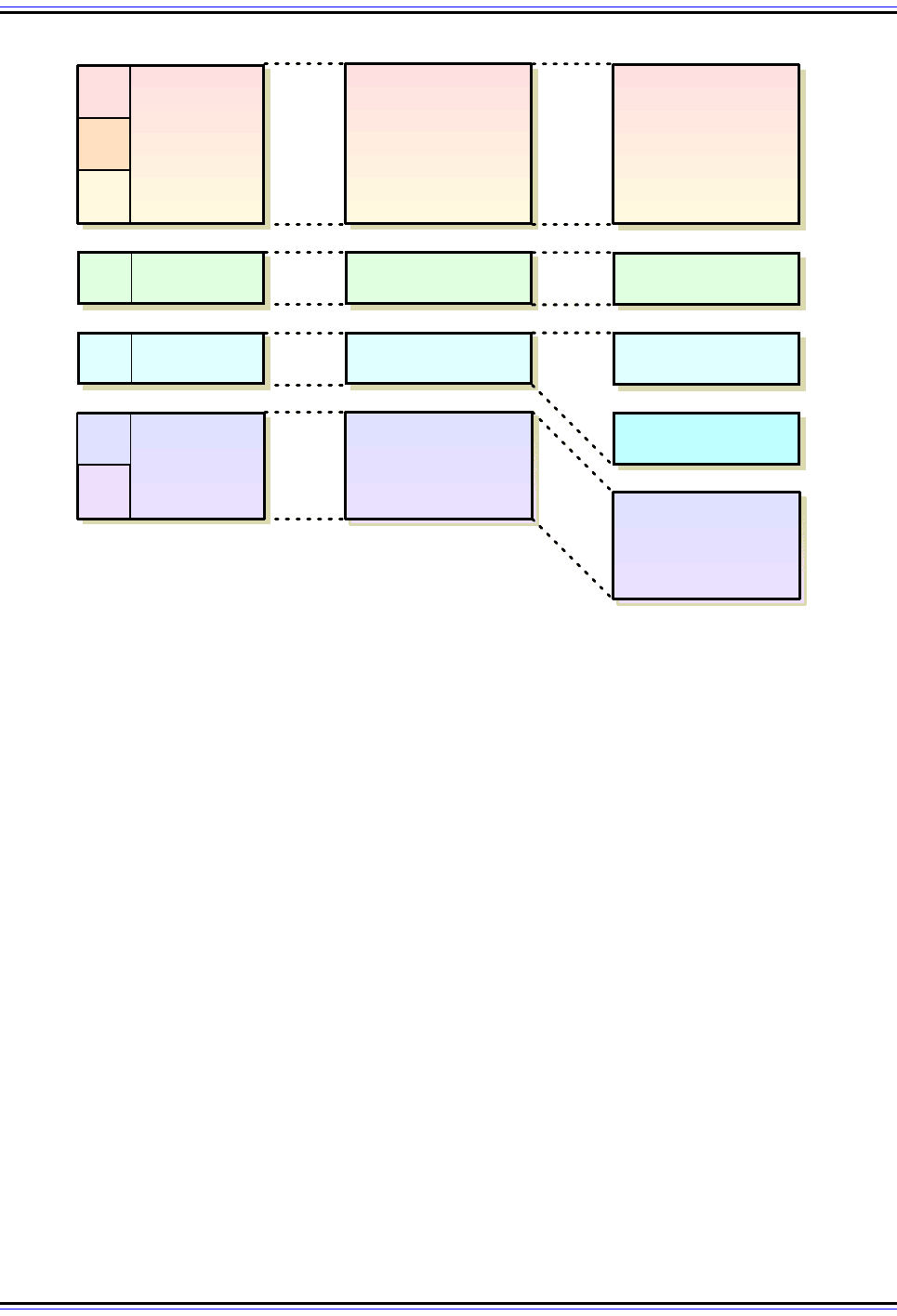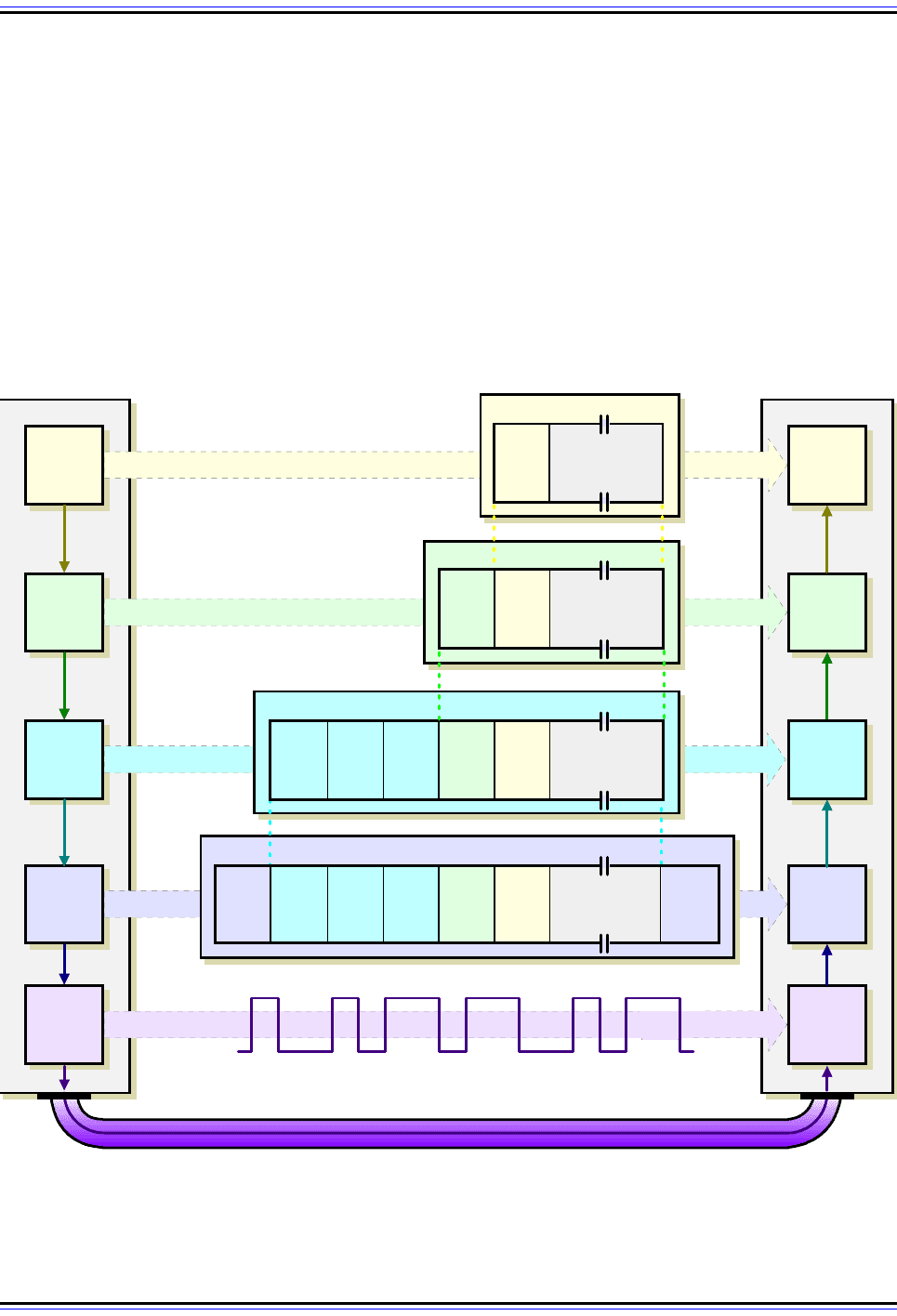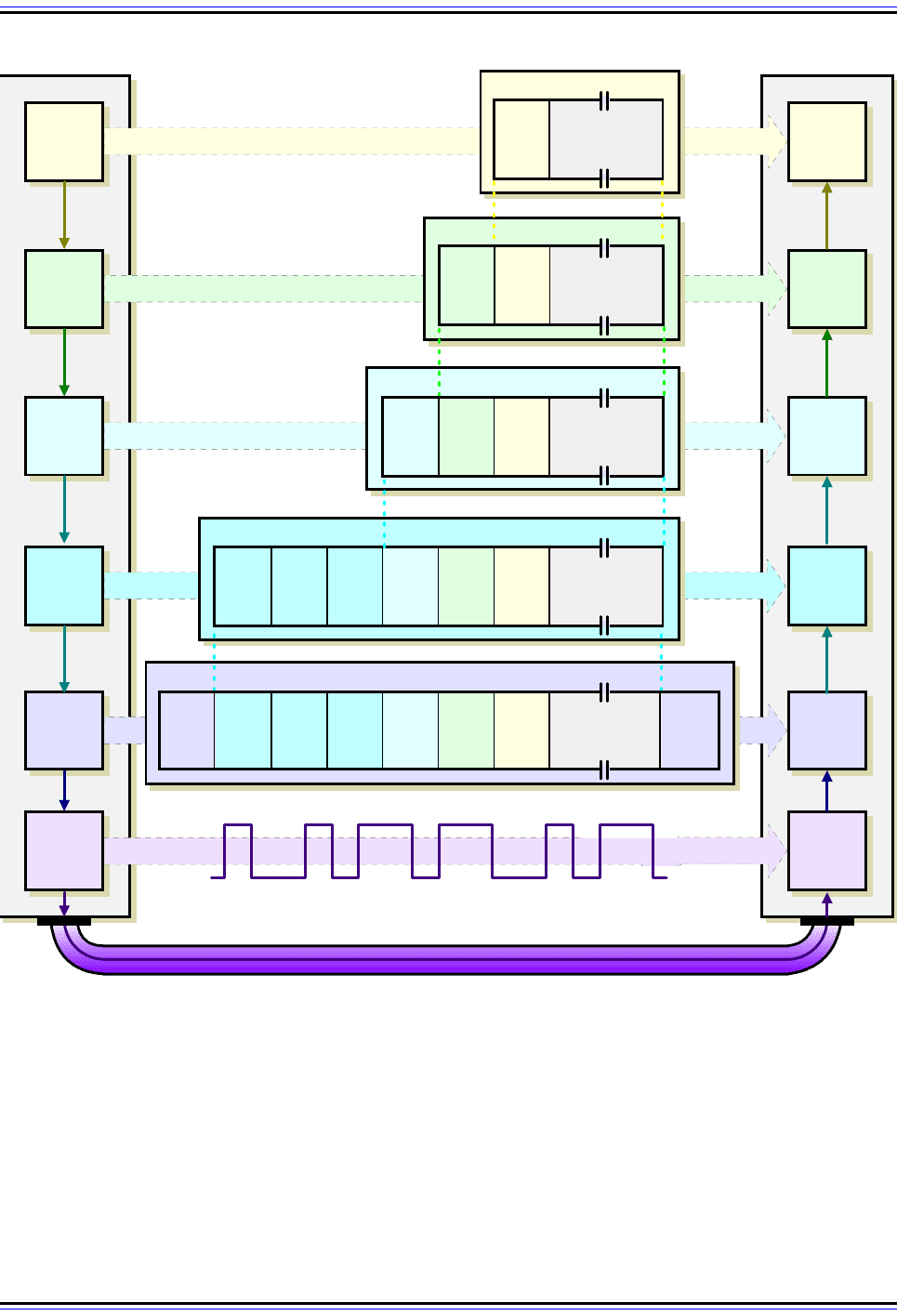Charles M. Kozierok The TCP-IP Guide
Подождите немного. Документ загружается.


The TCP/IP Guide - Version 3.0 (Contents) ` 551 _ © 2001-2005 Charles M. Kozierok. All Rights Reserved.
End Host Implementation
Putting IPSec into all host devices provides the most flexibility and security. It enables “end-
to-end” security between any two devices on the network. However, there are many hosts
on a typical network, so this means far more work than just implementing IPSec in routers.
Router Implementation
This option is much less work because it means we only make changes to a few routers
instead of hundreds or thousands of clients. It only provides protection between pairs of
routers that implement IPSec, but this may be sufficient for certain applications such as
virtual private networks (VPNs). The routers can be used to provide protection only for the
portion of the route that datagrams take outside the organization, leaving connections
between routers and local hosts unsecured (or possibly, secured by other means).
IPSec Architectures
Three different architectures are defined that describe methods for how to get IPSec into
the TCP/IP protocol stack.
Integrated Architecture
Under ideal circumstances, we would integrate IPSec's protocols and capabilities directly
into IP itself. This is the most elegant solution, as it allows all IPSec security modes and
capabilities to be provided just as easily as regular IP. No extra hardware or architectural
layers are needed.
IPv6 was designed to support IPSec, making this a viable option for hosts or routers. With
IPv4, integration would require making changes to the IP implementation on each device,
which is often impractical (to say the least!)
“Bump In The Stack” (BITS) Architecture
In this technique, IPSec is made a separate architectural layer between IP and the data link
layer; the cute name refers to the fact that IPSec is an extra element in the networking
protocol stack, as you can see in Figure 117. IPSec intercepts IP datagrams as they are
passed down the protocol stack, processes them to provide security, and then passes them
through to the data link layer.
The advantage of this technique is that IPSec can be “retrofitted” to any IP device, since the
IPSec functionality is separate from IP. The disadvantage is that there is duplication of effort
compared to the integrated architecture. BITS is generally used for IPv4 hosts.
“Bump In The Wire” (BITW) Architecture
In this method we add a hardware device that provides IPSec services. For example,
suppose we have a company with two sites. Each has a network that connects to the
Internet using a router that is not capable of IPSec functions. We can interpose a special

The TCP/IP Guide - Version 3.0 (Contents) ` 552 _ © 2001-2005 Charles M. Kozierok. All Rights Reserved.
“IPSec” device between the router and the Internet at both sites, as shown in Figure 118.
These devices will then intercept outgoing datagrams and add IPSec protection to them,
and strip it off incoming datagrams.
Just as BITS lets us add IPSec to legacy hosts, BITW can “retrofit” non-IPSec routers to
provide security benefits. The disadvantages are complexity and cost.
Parallels Between BITS and BITW
Incidentally, even though BITS and BITW seem quite different, they are really different ways
of doing the same thing. In the case of BITS we add an extra software layer that adds
security to existing IP datagrams; in BITW this same job is done by distinct hardware
devices. In both cases the result is the same, and the implications on the choice of IPSec
mode is likewise the same.
As we will see in the next topic, the choice of architecture has an important impact on which
of the two IPSec modes can be used.
Figure 117: IPSec “Bump In The Stack” (BITS) Architecture
In this type of IPSec implementation, IPSec becomes a separate layer in the TCP/IP stack. It is implemented
as software that sits below IP and adds security protection to datagrams created by the IP layer.
Upper Layer
Protocols
OSI and TCP/IP
Model Layers
Conventional
TCP/IP Protocol
Stack
TCP / UDP
IP
PPP/SLIP or
Data Link Layer
Drivers
Application
Transport
7
6
5
4
Internet3
Network
Interface
2
1
Upper Layer
Protocols
IPSec
"Bump In The Stack"
Implementation
TCP / UDP
IP
IPSec
PPP/SLIP or
Data Link Layer
Drivers

The TCP/IP Guide - Version 3.0 (Contents) ` 553 _ © 2001-2005 Charles M. Kozierok. All Rights Reserved.
Key Concept: Three different architectures or implementation models are defined
for IPSec. The best is integrated architecture, where IPSec is built into the IP layer of
devices directly. The other two are “Bump In The Stack” (BITS) and “Bump In The
Wire” (BITW), which both are ways of layering IPSec underneath regular IP, using software
and hardware solutions respectively.
IPSec Modes: Transport and Tunnel
Three different basic implementation architectures can be used to provide IPSec facilities to
TCP/IP networks. The choice of which implementation we use, as well as whether we
implement in end hosts or routers, impacts the specific way that IPSec functions. Two
specific modes of operation are defined for IPSec that are related to these architectures,
called transport mode and tunnel mode.
IPSec modes are closely related to the function of the two core protocols, the Authenti-
cation Header (AH) and Encapsulating Security Payload (ESP). Both of these protocols
provide protection by adding to a datagram a header (and possibly other fields) containing
security information. The choice of mode does not affect the method by which each
generates its header, but rather, changes what specific parts of the IP datagram are
protected and how the headers are arranged to accomplish this. In essence, the mode
really describes, not prescribes how AH or ESP do their thing. It is used as the basis for
defining other constructs, such as security associations (SAs).
Let’s take a look at how the two modes work.
Figure 118: IPSec “Bump In The Wire” (BITW) Architecture
In this IPSec architecture, IPSec is actually implemented in separate devices that sit between the devices that
wish to communicate securely. These repackage insecure IP datagrams for transport over the public Internet.
IP Datagrams
Internet
Network 1 Network 2
IP DatagramsSecure IP Datagrams
R1 R2IPSec Device
For R1
IPSec Device
For R2

The TCP/IP Guide - Version 3.0 (Contents) ` 554 _ © 2001-2005 Charles M. Kozierok. All Rights Reserved.
Transport Mode
As its name suggests, in transport mode, the protocol protects the message passed down
to IP from the transport layer. The message is processed by AH/ESP and the appropriate
header(s) added in front of the transport (UDP or TCP) header. The IP header is then
added in front of that by IP.
Another way of looking at this is as follows. Normally the transport layer packages data for
transmission and sends it to IP. From IP's perspective, this transport layer message is the
payload of the IP datagram. When IPSec is used in transport mode, the IPSec header is
applied only over this IP payload, not the IP header. The AH and/or ESP headers appears
between the original, single IP header and the IP payload. This is illustrated in Figure 119.
Figure 119: IPSec Transport Mode Operation
When IPSec operates in transport mode, it is integrated with IP and used to transport the upper layer (TCP/
UDP) message directly. After processing, the datagram has just one IP header that contains the AH and/or
ESP IPSec headers. Contrast to Figure 120.
Layer
2
TCP /
UDP
Upper
Layers
Upper
Layers
Upper Layer Msg
TCP/UDP Message
Layer 2 Frame
Layer
1
Layer
1
1 011011001001 011
Layer
2
TCP /
UDP
IP/
IPSec
IP/IPSec Datagram
IP/
IPSec
Layer2
Header
IP /
IPSec
Header
AH
Header
ESP
Header
TCP/
UDP
Header
Upper
Layer
Hdrs
Upper Layer
(Application)
Data
Layer2
Footer
IP /
IPSec
Header
AH
Header
ESP
Header
TCP/
UDP
Header
Upper
Layer
Hdrs
Upper Layer
(Application)
Data
TCP/
UDP
Header
Upper
Layer
Hdrs
Upper Layer
(Application)
Data
Upper
Layer
Hdrs
Upper Layer
(Application)
Data

The TCP/IP Guide - Version 3.0 (Contents) ` 555 _ © 2001-2005 Charles M. Kozierok. All Rights Reserved.
Tunnel Mode
In this mode, IPSec is used to protect a complete encapsulated IP datagram after the IP
header has already been applied to it. The IPSec headers appear in front of the original IP
header, and then a new IP header is added in front of the IPSec header. That is to say, the
entire original IP datagram is secured and then encapsulated within another IP datagram.
This is shown in Figure 120.
Comparing Transport and Tunnel Modes
The bottom line in understanding the difference between these two is this: tunnel mode
protects the original IP datagram as a whole, header and all, while transport mode does not.
Thus, in general terms, the order of the headers is as follows:
☯ Transport Mode: IP header, IPSec headers (AH and/or ESP), IP payload (including
transport header).
☯ Tunnel Mode: New IP header, IPSec headers (AH and/or ESP), old IP header, IP
payload.
Again, this is a simplified view of how IPSec datagrams are constructed; the reality is signif-
icantly more complex. The exact way that the headers are arranged in an IPSec datagram
in both transport and tunnel modes depends on which version of IP is being used; IPv6
uses extension headers which must be arranged in a particular way when IPSec is used.
The header placement also depends on which IPSec protocol is being used: AH or ESP.
Note that it is also possible to apply both AH and ESP to the same datagram; if so, the AH
header always appears before the ESP header.
There are thus three variables and eight basic combinations of mode (tunnel or transport),
IP version (IPv4 or IPv6) and protocol (AH or ESP). The two topics on AH and ESP
describe the four format combinations of transport/tunnel mode and IPv4/IPv6 applicable to
each protocol. Note that ESP also includes an ESP trailer that goes after the data
protected.
You could probably tell by reading these descriptions how the two modes relate to the
choice of IPSec architecture from the preceding topic. Transport mode requires that IPSec
be integrated into IP, because AH/ESP must be applied as the original IP packaging is
performed on the transport layer message. This is often the choice for implementations
requiring end-to-end security with hosts that run IPSec directly.
Tunnel mode represents an encapsulation of IP within the combination of IP+IPSec. Thus, it
corresponds with the BITS and BITW implementations, where IPSec is applied after IP has
processed higher-layer messages and already added its header. Tunnel mode is a common
choice for VPN implementations, which are based on tunneling of IP datagrams through an
unsecured network such as the Internet.

The TCP/IP Guide - Version 3.0 (Contents) ` 556 _ © 2001-2005 Charles M. Kozierok. All Rights Reserved.
Figure 120: IPSec Tunnel Mode Operation
IPSec tunnel mode is so named because it represents an encapsulation of a complete IP datagram, forming a
virtual tunnel between IPSec-capable devices. The IP datagram is passed to IPSec, where a new IP header is
created with the AH and/or ESP IPSec headers.added. Contrast to Figure 119.
Layer
2
IP
TCP /
UDP
Upper
Layers
Upper
Layers
Upper Layer Msg
TCP/UDP Message
IP Datagram
Layer 2 Frame
Layer
1
Layer
1
1 011011001001 011
Layer
2
IP
TCP /
UDP
IPSec
Encapsulating IP/IPSec Datagram
IPSec
Layer2
Header
New IP
Header
AH
Header
ESP
Header
IP
Header
TCP/
UDP
Header
Upper
Layer
Hdrs
Upper Layer
(Application)
Data
Layer2
Footer
New IP
Header
AH
Header
ESP
Header
IP
Header
TCP/
UDP
Header
Upper
Layer
Hdrs
Upper Layer
(Application)
Data
IP
Header
TCP/
UDP
Header
Upper
Layer
Hdrs
Upper Layer
(Application)
Data
TCP/
UDP
Header
Upper
Layer
Hdrs
Upper Layer
(Application)
Data
Upper
Layer
Hdrs
Upper Layer
(Application)
Data

The TCP/IP Guide - Version 3.0 (Contents) ` 557 _ © 2001-2005 Charles M. Kozierok. All Rights Reserved.
Key Concept: IPSec has two basic modes of operation. In transport mode, IPSec
AH and/or ESP headers are added as the original IP datagram is created; this mode
is associated with integrated IPSec architectures. In tunnel mode, the original IP
datagram is created normally, then the entire datagram is encapsulated into a new IP
datagram containing the AH/ESP IPSec headers. This mode is most commonly used with
“Bump In The Stack” and “Bump In The Wire” implementations.
IPSec Security Associations and the Security Association Database
(SAD); Security Policies and the Security Policy Database (SPD);
Selectors; the Security Parameter Index (SPI)
Woah, there sure is a lot of "security" stuff in that topic title. Those items are all closely
related, and important to understand before we proceed to looking at the core IPSec
protocols themselves. These constructs are used to guide the operation of IPSec in a
general way and also in particular exchanges between devices. They control how IPSec
works and ensure that each datagram coming into or leaving an IPSec-capable device is
properly treated.
Where to start… where to start. ☺ Let's begin by considering the problem of how to apply
security in a device that may be handling many different exchanges of datagrams with
others. There is overhead involved in providing security, so we do not want to do it for every
message that comes in or out. Some types of messages may need more security, others
less. Also, exchanges with certain devices may require different processing than others.
Security Policies, Security Associations and Associated Databases
To manage all of this complexity, IPSec is equipped with a flexible, powerful way of speci-
fying how different types of datagrams should be handled. To understand how this works,
we must first define two important logical concepts:
☯ Security Policies: A security policy is a rule that is programmed into the IPSec imple-
mentation that tells it how to process different datagrams received by the device. For
example, security policies are used to decide if a particular packet needs to be
processed by IPSec or not; those that do not bypass AH and ESP entirely. If security is
required, the security policy provides general guidelines for how it should be provided,
and if necessary, links to more specific detail.
Security policies for a device are stored in the device's Security Policy Database
(SPD).
☯ Security Associations: A Security Association (SA) is a set of security information
that describes a particular kind of secure connection between one device and another.
You can consider it a "contract", if you will, that specifies the particular security mecha-
nisms that are used for secure communications between the two.
A device's security associations are contained in its Security Association Database
(SAD).

The TCP/IP Guide - Version 3.0 (Contents) ` 558 _ © 2001-2005 Charles M. Kozierok. All Rights Reserved.
It's often hard to distinguish the SPD and the SAD, since they are similar in concept. The
main difference between them is that security policies are general while security associa-
tions are more specific. To determine what to do with a particular datagram, a device first
checks the SPD. The security policies in the SPD may reference a particular security
association in the SAD. If so, the device will look up that security association and use it for
processing the datagram.
Selectors
One issue we haven't covered yet is how a device determines what policies or SAs to use
for a specific datagram. Again here, IPSec defines a very flexible system that lets each
security association define a set of rules for choosing datagrams that the SA applies to.
Each of these rule sets is called a selector. For example, a selector might be defined that
says that a particular range of values in the Source Address of a datagram, combined with
another value in the Destination Address, means a specific SA must be used for the
datagram.
Let's now come back to security associations, which are a very important concept in IPSec.
Each secure communication that a device makes to another requires that an SA be estab-
lished. SAs are unidirectional, so each one only handles either inbound or outbound traffic
for a particular device. This allows different levels of security to be implemented for a flow
from device A to device B, than for traffic coming from device B to device A. In a bidirec-
tional communication of this sort, both A and B would have two SAs; A would have SAs we
could call "SAdeviceBin" and "SAdeviceBout". Device B would have SAs "SAdeviceAin"
and "SAdeviceAout".
Security Association Triples and the Security Parameter Index (SPI)
Security associations don't actually have names, however. They are instead defined by a
set of three parameters, called a triple:
☯ Security Parameter Index (SPI): A 32-bit number that is chosen to uniquely identify a
particular SA for any connected device. The SPI is placed in AH or ESP datagrams
and thus links each secure datagram to the security association. It is used by the
recipient of a transmission so it knows what SA governs the datagram.
☯ IP Destination Address: The address of the device for whom the SA is established.
☯ Security Protocol Identifier: Specifies whether this association is for AH or ESP. If
both are in use with this device they have separate SAs.
As you can see, the two security protocols AH and ESP are dependent on security associa-
tions and policies and the various databases that control their operation. Management of
these databases is important, but another whole complex subject. Generally, SAs can either
be set up manually (which is of course extra work) or an automated system can be
deployed using a protocol like IKE.
Confused? I don't blame you, despite my best efforts, and remember that this is all highly
simplified. Welcome to the wonderful world of networking security. If you are ever besieged
by insomnia, I highly recommend RFC 2401. ☺

The TCP/IP Guide - Version 3.0 (Contents) ` 559 _ © 2001-2005 Charles M. Kozierok. All Rights Reserved.
IPSec Authentication Header (AH)
One of the two core security protocols in IPSec is the Authentication Header (AH). This is
another protocol whose name has been well chosen: AH is a protocol that provides authen-
tication of either all or part of the contents of a datagram through the addition of a header
that is calculated based on the values in the datagram. What parts of the datagram are
used for the calculation, and the placement of the header, depends on the mode (tunnel or
transport) and the version of IP (IPv4 or IPv6).
The operation of the AH protocol is surprisingly simple—especially for any protocol that has
anything to do with network security. It can be considered analogous to the algorithms used
to calculate checksums or perform CRC checks for error detection. In those cases, a
standard algorithm is used by the sender to compute a checksum or CRC code based on
the contents of a message. This computed result is transmitted along with the original data
to the destination, which repeats the calculation and discards the message if any
discrepancy is found between its calculation and the one done by the source.
This is the same idea behind AH, except that instead of using a simple algorithm known to
everyone, we use a special hashing algorithm and a specific key known only to the source
and the destination. A security association between two devices is set up that specifies
these particulars so that the source and destination know how to perform the computation
but nobody else can. On the source device, AH performs the computation and puts the
result (called the Integrity Check Value or ICV) into a special header with other fields for
transmission. The destination device does the same calculation using the key the two
devices share, which enables it to see immediately if any of the fields in the original
datagram were modified (either due to error or malice).
It's important that I point out explicitly that just as a checksum doesn't change the original
data, neither does the ICV calculation change the original data. The presence of the AH
header allows us to verify the integrity of the message, but doesn't encrypt it. Thus, AH
provides authentication but not privacy (that's what ESP is for. No, I don’t mean using a
psychic, I mean the other IPSec core protocol!)
Authentication Header Datagram Placement and Linking
The calculation of the authentication header is similar for both IPv4 and IPv6. One
difference is in the exact mechanism used for placing the header into the datagram and for
linking the headers together. I'll describe IPv6 first since it is simpler, as AH was really
designed to fit into IPv6’s mechanism for this.
IPv6 Authentication Header Placement and Linking
The AH is inserted into the IP datagram as an extension header, following the normal IPv6
rules for extension header linking. It is linked by the previous header (extension or main)
putting into its Next Header field the assigned value for the AH header (51). The AH header
then links to the next extension header or the transport layer header using its Next Header
field.

The TCP/IP Guide - Version 3.0 (Contents) ` 560 _ © 2001-2005 Charles M. Kozierok. All Rights Reserved.
In transport mode, the AH is placed into the main IP header and appears before any Desti-
nation Options header containing options intended for the final destination, and before an
ESP header if present, but after any other extension headers. In tunnel mode, it appears as
an extension header of the new IP datagram that encapsulates the original one being
tunneled. This is shown graphically in Figure 121.
IPv4 Authentication Header Placement and Linking
A method that is similar to the IPv6 header linking technique is employed. In an IPv4
datagram, the Protocol field indicates the identity of the higher layer protocol (typically TCP
or UDP) carried in the datagram. As such, this field “points” to the next header, which is at
the front of the IP payload. AH takes this value and puts it into its Next Header field, and
then places the protocol value for AH itself (51 decimal) into the IP Protocol field. This
makes the IP header “point” to the AH, which then “points” to whatever the IP datagram
pointed to before.
Again, in transport mode, the authentication header is added after the main IP header of the
original datagram; in tunnel mode it is added after the new IP header that encapsulates the
original datagram being tunneled. This is shown in Figure 122.
Key Concept: The IPSec Authentication Header (AH) protocol allows the recipient
of a datagram to verify its authenticity. It is implemented as a header added to an IP
datagram that contains an integrity check value computed based on the values of the
fields in the datagram. This value can be used by the recipient to ensure that the data has
not been changed in transit. The Authentication Header does not encrypt data and thus
does not ensure the privacy of transmissions.
